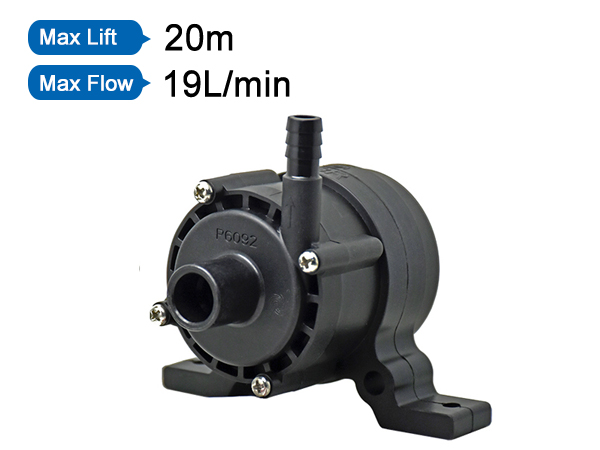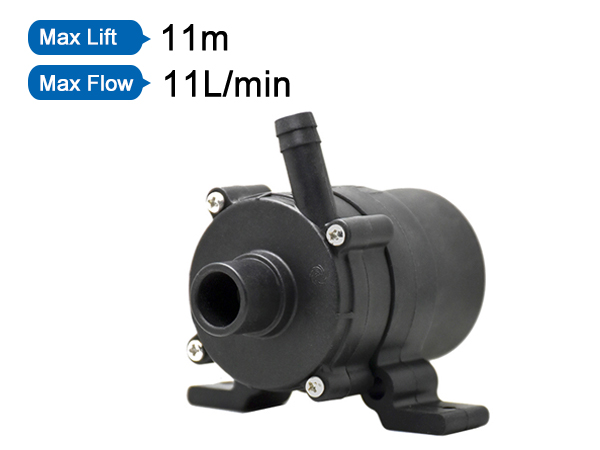The Key Role of Liquid Cooling Water Pumps in 5G Base Station Heat Dissipation
Published:2025-07-30
With the rapid development and widespread popularization of 5G technology, 5G base stations, as core infrastructure, their stable operation is crucial to ensuring high-speed and reliable communication services. However, 5G base station equipment generates a large amount of heat during operation, posing severe challenges to heat dissipation systems. An efficient heat dissipation solution has become a key factor in ensuring the performance, reliability, and reducing operating costs of 5G base stations. Among various heat dissipation technologies, liquid cooling systems stand out for their excellent heat dissipation performance, and liquid cooling water pumps, as the core components of such systems, play an indispensable key role. In-depth research on the application of liquid cooling water pumps in 5G base station heat dissipation is of great practical significance for promoting the sustained and healthy development of 5G technology.

I. High Energy Consumption and Heat Generation Characteristics of 5G Base Stations
1. High-frequency and high-power equipment operation generates massive heat
Compared with 4G base stations, 5G base stations use higher frequency bands, significantly increasing signal processing complexity. To achieve high-speed, low-latency data transmission, key equipment in 5G base stations such as power amplifiers and baseband processing units must operate continuously under high-power conditions. Take power amplifiers as an example: their output power is usually several tens of watts or higher, and most electrical energy is converted into heat during operation, causing the equipment temperature to rise sharply. Relevant studies show that the power consumption of 5G base stations is 2-3 times higher than that of 4G base stations, and the corresponding heat generation has also increased significantly.
2. Compact equipment layout exacerbates heat dissipation difficulties
To meet space utilization and communication needs, the internal equipment layout of 5G base stations is extremely compact. Devices such as Active Antenna Units (AAU) and Radio Units (RU) are closely arranged, leading to concentrated heat and limited heat dissipation space. This compact layout hinders natural air convection for heat dissipation, making it difficult for heat to quickly dissipate into the surrounding environment, which in turn causes local overheating of equipment, seriously affecting equipment performance and lifespan. For example, in some miniaturized and integrated 5G base stations, the gap between devices is less than a few centimeters, resulting in obvious heat accumulation effects, and conventional heat dissipation methods cannot meet the heat dissipation requirements.
3. 24/7 operation demands high reliability of heat dissipation
5G base stations need to operate 24/7 to ensure the continuous stability of the communication network. During long-term operation, heat generated by equipment accumulates continuously. If the heat dissipation system fails to work reliably, base station equipment will frequently malfunction due to overheating. In harsh environments such as high temperature and high humidity, heat dissipation problems become more prominent. For instance, during high-temperature periods in summer, the ambient temperature of outdoor base stations often exceeds 35°C. Coupled with the equipment's own heat generation, the heat dissipation system must withstand enormous pressure, making reliable heat dissipation under various working conditions a key challenge.
II. Heat Dissipation Principle and Advantages of Liquid Cooling Water Pumps
1. Heat dissipation principle of liquid cooling water pumps
Liquid cooling water pumps act as the power core in the liquid cooling system of 5G base stations. Their working principle is based on the efficient heat transfer characteristics of liquids. In a closed liquid cooling circulation loop, cooling fluid (usually deionized water or special coolant) is driven by the liquid cooling water pump to flow at a certain speed through water-cooled plates closely attached to heat-generating equipment. Since the specific heat capacity of liquids is much higher than that of air, they can quickly absorb a large amount of heat emitted by the equipment, increasing the temperature of the cooling fluid. Subsequently, the cooling fluid carrying heat is pumped to the heat exchanger, where high-temperature cooling fluid exchanges heat with external cooling media (such as air or outdoor circulating water), releasing heat into the external environment and reducing its own temperature. The cooled cooling fluid is then transported back to the water-cooled plates by the liquid cooling water pump, cycling repeatedly to achieve continuous heat dissipation for 5G base station equipment.
2. Advantages of liquid cooling water pumps
2.1 Efficient heat dissipation capability: The thermal conductivity of liquids is much higher than that of air; for example, the thermal conductivity of water is approximately 25 times that of air. This enables liquid cooling systems driven by liquid cooling water pumps to remove equipment heat more efficiently, significantly reducing equipment temperature compared to traditional air cooling. Experimental data shows that under the same heat dissipation conditions, liquid cooling systems can reduce the operating temperature of 5G base station equipment by 10-15°C, effectively improving equipment performance and stability.
2.2 Precise temperature control: Liquid cooling water pumps can precisely control the heat dissipation rate of equipment by adjusting the flow rate of cooling fluid, achieving accurate regulation of equipment temperature. During the operation of 5G base station equipment, heat generation varies under different working conditions. Liquid cooling water pumps can automatically adjust the cooling fluid flow rate based on signals feedback from temperature sensors, keeping the equipment temperature within the set optimal operating range and avoiding damage caused by temperature fluctuations.
2.3 Low-noise operation: Compared with the high noise generated by high-speed fans in traditional air cooling systems, liquid cooling water pumps mainly produce water flow sound, resulting in significantly lower noise levels. This is particularly advantageous in noise-sensitive environments (such as base stations near residential areas or hospitals), effectively reducing noise interference to the surrounding environment.
2.4 Energy saving and consumption reduction: Due to high heat dissipation efficiency, liquid cooling systems require lower energy consumption than air cooling systems to achieve the same heat dissipation effect. The power of liquid cooling water pumps is relatively small, and system energy consumption can be further reduced through reasonable optimization of circulation pipelines and control strategies. Studies show that 5G base stations using liquid cooling systems can reduce the energy consumption of refrigeration systems by 30%-50% compared to air-cooled base stations, helping to achieve green communication and energy conservation goals.

III. Comparison with Traditional Heat Dissipation Methods
1. Limitations of air cooling
Traditional air cooling dissipates heat from equipment surfaces by forcing air flow through fans. However, in the high-heat, compact layout environment of 5G base stations, air cooling exhibits numerous shortcomings. Air has poor thermal conductivity and low heat dissipation efficiency, making it difficult to meet the heat dissipation needs of 5G base station equipment. Increasing fan speed to enhance heat dissipation not only increases energy consumption but also generates high noise, affecting the surrounding environment. Additionally, air cooling systems are highly susceptible to ambient temperature; their heat dissipation capacity drops significantly in high-temperature environments, failing to ensure stable operation of base station equipment. For example, in hot summer, when the ambient temperature approaches or exceeds 35°C, air-cooled base station equipment often triggers overheating alarms or even shuts down.
2. Significant improvement in heat dissipation efficiency with liquid cooling water pumps
Liquid cooling systems driven by liquid cooling water pumps far outperform air cooling in terms of heat dissipation efficiency. As mentioned earlier, the excellent thermal conductivity of liquids enables faster and more efficient heat transfer. Taking a certain model of 5G base station as an example, when using air cooling, the equipment temperature under full load can exceed 70°C; after switching to a liquid cooling system, the equipment temperature can be stably controlled at around 50°C, showing a significant improvement in heat dissipation efficiency. This is attributed to liquid cooling water pumps ensuring that the cooling fluid flows at an appropriate speed in the circulation loop, enabling efficient heat exchange between water-cooled plates and equipment, and quickly transferring heat out.
3. Comparison of energy-saving effects
In terms of energy consumption, liquid cooling systems demonstrate obvious advantages through the efficient operation of liquid cooling water pumps. To achieve effective heat dissipation, air cooling systems require fans to run continuously at high speeds, consuming large amounts of electrical energy. Statistics show that the air conditioning energy consumption of air-cooled base stations accounts for 15%-50% of the total energy consumption of the equipment room. In contrast, the power consumption of liquid cooling water pumps in liquid cooling systems is relatively low, and the overall energy consumption of the refrigeration system can be significantly reduced by optimizing cooling fluid flow and temperature control. Practical application data shows that 5G base stations using liquid cooling have a PUE (Power Usage Effectiveness) value 0.2-0.3 lower than that of air-cooled base stations, with significant energy-saving effects, helping to reduce operators' operating costs.
4. Comparison of adaptability to complex environments
5G base stations are often deployed in various complex environments, requiring high environmental adaptability of heat dissipation systems. Air cooling systems are greatly affected by factors such as ambient temperature and humidity; their heat dissipation performance declines sharply in high-temperature and high-humidity environments. Moreover, dust and impurities in the air easily accumulate on equipment surfaces and fans, affecting heat dissipation efficiency and increasing equipment maintenance costs. In contrast, liquid cooling systems have stronger environmental adaptability. Liquid cooling water pumps and circulation pipelines adopt a sealed design, which can effectively prevent external impurities from entering. The cooling fluid is not easily affected by the environment and can operate stably in harsh environments, ensuring the normal operation of base station equipment. For example, in coastal high-salt-fog areas and desert high-dust areas, the failure rate of liquid-cooled base stations is significantly lower than that of air-cooled base stations.
The high energy consumption and heat generation characteristics of 5G base stations pose huge challenges to heat dissipation, and liquid cooling water pumps play a key role in the liquid cooling systems of 5G base stations. By efficiently driving the circulation of cooling fluid, liquid cooling water pumps enable liquid cooling systems to exhibit significant advantages such as high-efficiency heat dissipation, precise temperature control, low-noise operation, and energy saving, showing obvious performance improvements compared to traditional air cooling methods. Practical base station cases show that using liquid cooling systems equipped with liquid cooling water pumps can effectively reduce equipment temperature, improve communication stability, reduce failure rates and energy consumption, providing strong support for the reliable operation of 5G base stations. With the continuous development of 5G technology and the continuous expansion of application scenarios, liquid cooling water pumps, as core components for 5G base station heat dissipation, will play a more important role in improving 5G network performance and promoting the development of green communication, worthy of further in-depth research and widespread promotion.
- Distribution in Water Heater Mattresses: Why BLDC Pumps Ensure Uniform Heating
- How BLDC Pumps Ensure Precise Flow in Water Dispensers
- Why BLDC Pumps Are Essential for Smart Toilets
- The Critical Role of Automotive Electronic Water Pumps in New Energy Vehicle Battery Thermal Management
- Noise Control Technology for Smart Toilet Water Pumps: Enhancing Quiet Operation in Modern Bathrooms
- Unveiling the Working Principle of Automotive Electronic Water Valves
- Comparative Analysis of Liquid-Cooled Pumps vs. Air-Cooled Systems for EV Charging Stations
- Technical Application of Brushless DC Motors in Energy Storage Circulation Pumps
- Water Heater Pump: Efficiency Upgrade for Low-Voltage Systems
- How Dishwasher Water Pumps Enhance Cleaning Coverage Through Stable Operation?
